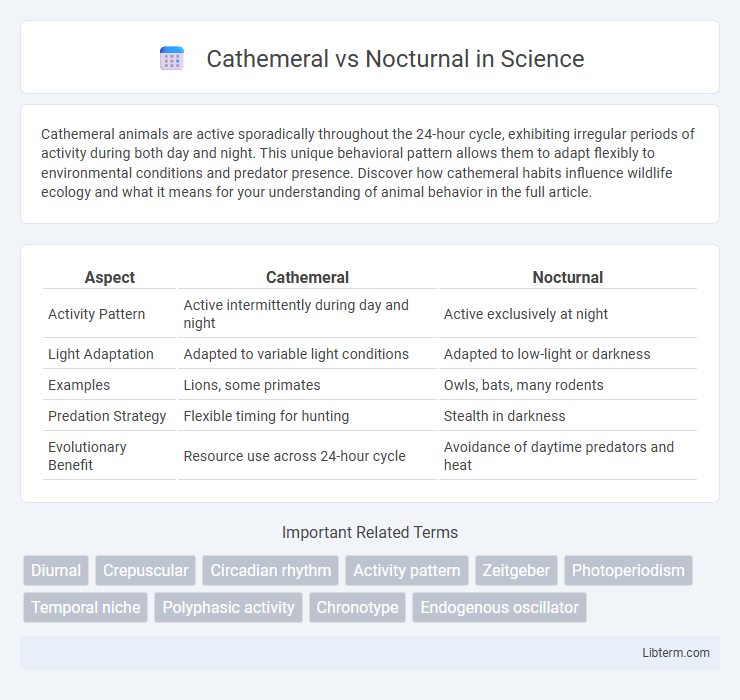Cathemeral animals are active sporadically throughout the 24-hour cycle, exhibiting irregular periods of activity during both day and night. This unique behavioral pattern allows them to adapt flexibly to environmental conditions and predator presence. Discover how cathemeral habits influence wildlife ecology and what it means for your understanding of animal behavior in the full article.
Table of Comparison
| Aspect | Cathemeral | Nocturnal |
|---|---|---|
| Activity Pattern | Active intermittently during day and night | Active exclusively at night |
| Light Adaptation | Adapted to variable light conditions | Adapted to low-light or darkness |
| Examples | Lions, some primates | Owls, bats, many rodents |
| Predation Strategy | Flexible timing for hunting | Stealth in darkness |
| Evolutionary Benefit | Resource use across 24-hour cycle | Avoidance of daytime predators and heat |
Understanding Cathemeral and Nocturnal Activity Patterns
Cathemeral animals exhibit irregular activity patterns, being active both day and night at intervals that vary across species or environmental conditions. In contrast, nocturnal animals are primarily active during the night, resting or hiding during daylight hours to avoid predators or extreme heat. Understanding these activity patterns aids in ecological studies, conservation efforts, and managing habitat requirements for different species.
Defining Cathemeral: What Does It Mean?
Cathemeral animals exhibit irregular activity patterns, being active sporadically during both day and night according to environmental conditions. This behavior contrasts with strict nocturnal species, which limit their activity exclusively to nighttime hours. Understanding cathemerality involves recognizing its adaptive advantage in unpredictably fluctuating habitats, enabling flexible foraging and predator avoidance strategies.
Characteristics of Nocturnal Behavior
Nocturnal behavior is characterized by heightened activity during nighttime hours, often accompanied by enhanced senses such as superior night vision and acute hearing to navigate low-light environments. Animals exhibiting nocturnal traits typically rest or reduce activity during daylight, conserving energy and avoiding predators or extreme heat. This adaptation supports foraging, mating, and shelter-seeking under the cover of darkness, crucial for species survival in specific ecological niches.
Key Differences Between Cathemeral and Nocturnal Animals
Cathemeral animals exhibit activity sporadically throughout the 24-hour cycle, with periods of both day and night activity, while nocturnal animals are primarily active during the night. Cathemerality allows greater flexibility in foraging and predator avoidance based on environmental conditions, unlike strict nocturnality which is adapted to nighttime resource availability and reduced competition. Species like some lemurs demonstrate cathemeral behavior, contrasting with nocturnal creatures such as owls that rely on night vision and sensory adaptations optimized for darkness.
Evolutionary Advantages of Cathemeral Activity
Cathemeral activity, characterized by irregular intervals of activity during both day and night, offers evolutionary advantages such as increased flexibility in resource acquisition and predator avoidance compared to strict nocturnal behavior. This adaptability allows species to exploit diverse environmental niches and optimize energy use across variable habitats. Consequently, cathemerality enhances survival and reproductive success by reducing competition and responding effectively to fluctuating ecological pressures.
Adaptations for Life After Dark: Nocturnal Traits
Nocturnal animals exhibit specialized adaptations such as enhanced night vision with a high density of rod cells in their retinas, allowing superior low-light perception. Their acute hearing and olfactory senses compensate for limited visibility, guiding navigation and hunting in darkness. Behavioral traits like reduced body temperature and slower metabolism optimize energy use during nighttime activity.
Examples of Cathemeral Species
Cathemeral species, such as the African elephant (Loxodonta africana) and the red-backed bearded saki (Chiropotes satanas), exhibit irregular activity patterns throughout the 24-hour cycle, unlike strictly nocturnal animals like owls or bats. These animals adapt their active periods based on environmental factors, food availability, and predation risk, allowing them to be flexible in their daily habits. Cathemerality provides an evolutionary advantage in diverse habitats by optimizing resource use and minimizing competition with diurnal and nocturnal species.
Common Nocturnal Animals and Their Habitats
Common nocturnal animals, such as owls, bats, and raccoons, are adapted to active life during the night, inhabiting diverse environments like forests, deserts, and urban areas. These species rely on enhanced night vision, acute hearing, and stealth to hunt or forage under low light conditions, which helps reduce predation and competition. Their habitats often feature ample cover and food resources that support nocturnal behavior patterns distinct from cathemeral animals, which are active sporadically throughout the 24-hour cycle.
Environmental Influences on Activity Rhythms
Environmental factors such as light availability, temperature, and predation risk significantly influence cathemeral and nocturnal activity rhythms. Cathemeral animals adapt by distributing their activity periods throughout both day and night to optimize energy use and resource access in varying ecological conditions. Nocturnal species, conversely, concentrate activity during low-light conditions to avoid predators and reduce thermal stress in hot environments.
Cathemeral vs Nocturnal: Implications for Conservation
Cathemeral animals, active sporadically throughout the 24-hour cycle including both day and night, exhibit flexible behavior that challenges standard conservation strategies designed for strictly nocturnal species, which are active predominantly during nighttime. Understanding the temporal activity patterns of cathemeral versus nocturnal species is crucial for habitat management, as differing light exposure and predator-prey interactions impact their survival and reproduction. Conservation efforts must incorporate species-specific circadian rhythms to optimize protective measures, mitigate human-wildlife conflict, and enhance the effectiveness of monitoring protocols.
Cathemeral Infographic

 libterm.com
libterm.com